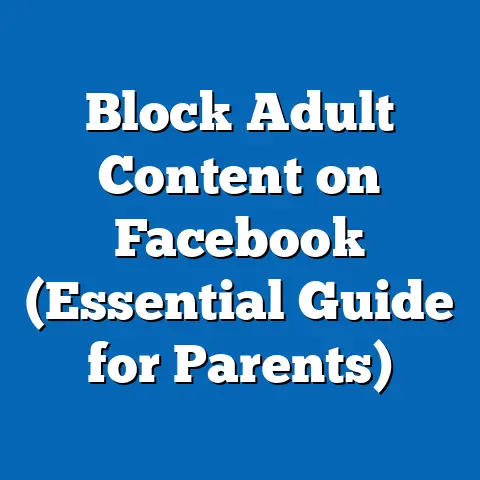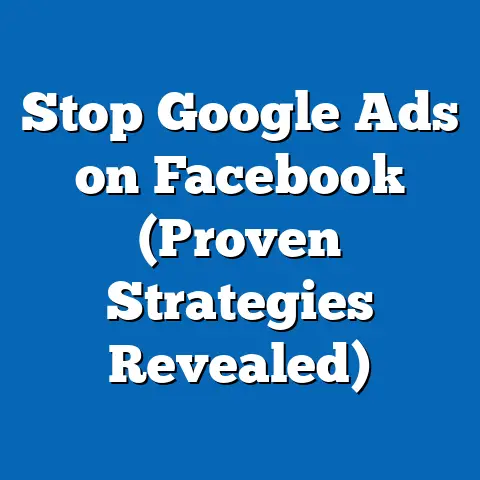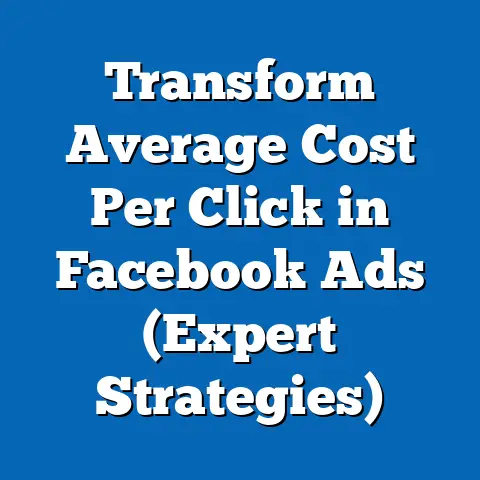Craft Perfect Facebook Mobile Ads (Essential Dimensions)
In the rapidly evolving landscape of digital marketing, the use of targeted mobile advertisements on platforms like Facebook has become a critical tool for political campaigns and advocacy groups. This trend is particularly pronounced among younger, tech-savvy demographics who increasingly consume political content through mobile devices. As political engagement shifts to digital spaces, understanding the art of crafting effective Facebook mobile ads is essential for influencing voter behavior, shaping public opinion, and mobilizing support.
The Trend: Rise of Mobile Political Advertising on Facebook
The proliferation of smartphones and social media has fundamentally transformed political communication, with Facebook emerging as a dominant platform for reaching voters. According to a 2022 report by Pew Research Center, 70% of U.S. adults use Facebook, and over 60% of them access the platform via mobile devices daily. Among younger adults aged 18-29, mobile usage is even higher, with 84% reporting frequent access through smartphones.
This trend is particularly significant for political campaigns, as mobile ads allow for hyper-targeted messaging based on user data such as location, interests, and behavior. A 2020 study by the Digital Advertising Alliance found that political ad spending on digital platforms, including mobile ads, reached $2.8 billion during the U.S. presidential election cycle, with Facebook accounting for a substantial share. Unlike traditional media, mobile ads on Facebook enable real-time engagement, making them a powerful tool for shaping political narratives.
Demographic Makeup of Target Audiences
The primary audience for Facebook mobile political ads skews younger and more diverse compared to traditional political media consumers. Data from Statista (2023) indicates that 79% of U.S. adults aged 18-34 are active on Facebook, with a significant portion identifying as racial or ethnic minorities—approximately 40% of this age group are non-white. Additionally, urban dwellers are overrepresented among frequent mobile users, with 65% of urban residents accessing Facebook daily via mobile devices compared to 55% in rural areas (Pew Research, 2022).
Education levels also play a role, as college-educated individuals are more likely to engage with political content on social media, with 72% of degree holders reporting exposure to political ads on platforms like Facebook (American National Election Studies, 2020). Gender differences are less pronounced, though women are slightly more likely to use Facebook (73% vs. 67% for men), influencing ad targeting strategies. These demographics contrast with older, less diverse audiences who rely on television or print media for political information, highlighting a generational and technological divide.
Core Beliefs and Values
The core beliefs of those most engaged with Facebook mobile political ads often align with progressive or reformist ideologies, particularly among younger users. A 2021 survey by YouGov found that 62% of 18-29-year-olds on social media platforms express support for policies addressing climate change, social justice, and economic inequality—issues frequently highlighted in targeted political ads. This group also values transparency and authenticity in political messaging, often responding positively to ads that feature personal stories or grassroots activism over polished, corporate-style campaigns.
In contrast, older demographics (50+) who engage with political content on Facebook tend to prioritize issues like national security and economic stability, with 58% expressing conservative leanings in a 2022 Gallup poll. These differences in values shape the tone and content of mobile ads, with campaigns tailoring messages to resonate with specific ideological priorities. The emphasis on social issues among younger users distinguishes them from older, more traditional voters who may be less active on mobile platforms.
Voting Patterns and Political Engagement
Younger Facebook users targeted by mobile ads demonstrate distinct voting patterns compared to other groups. According to the U.S. Census Bureau’s 2020 Current Population Survey, voter turnout among 18-29-year-olds was 51%, significantly lower than the 67% turnout for those aged 45-64. However, digital engagement has proven effective in mobilizing this demographic, with a 2020 study by the Center for Information and Research on Civic Learning and Engagement (CIRCLE) finding that 74% of young voters exposed to targeted social media ads reported a higher likelihood of voting.
Political engagement through mobile ads also fosters activism beyond voting, such as sharing content or participating in online discussions. Data from the Harvard Kennedy School (2021) shows that 68% of 18-34-year-olds have shared political content on social media, compared to just 42% of those over 50. This high level of digital interaction sets younger, mobile-savvy audiences apart from older voters who engage more passively with political content through traditional media.
Distinguishing Characteristics Compared to Other Groups
The audience for Facebook mobile political ads is distinguished by its technological fluency and preference for interactive, personalized content. Unlike television or radio audiences, who consume political messaging in a linear, one-way format, mobile users expect dynamic engagement—commenting, sharing, and reacting to ads in real time. A 2022 report by eMarketer noted that 65% of mobile users are more likely to engage with ads that include interactive elements like polls or clickable calls-to-action, a feature less relevant to traditional media consumers.
Additionally, the reliance on data-driven targeting sets mobile ad audiences apart. Campaigns can segment users by demographics, interests, and even past voting behavior, a precision unattainable in broadcast media. This hyper-personalization contrasts with the broader, less tailored approach of traditional political advertising, underscoring a key divide between digital and analog political engagement.
Essential Dimensions of Crafting Perfect Facebook Mobile Ads
To effectively reach and influence these diverse audiences, political campaigns must focus on several critical dimensions when designing Facebook mobile ads. These include visual and textual elements, targeting strategies, timing and frequency, and alignment with demographic values. Each dimension requires a nuanced approach to maximize impact and engagement.
Visual and Textual Elements
Mobile ads must prioritize concise, visually striking content due to the limited screen space and short attention spans of users. Research by Facebook’s own analytics team (2021) indicates that ads with bold imagery or short videos (under 15 seconds) achieve 60% higher engagement rates than static, text-heavy posts. Bright colors, emotive imagery, and clear branding are essential for capturing attention in a crowded newsfeed.
Textually, messages should be direct and action-oriented, with calls-to-action like “Vote Now” or “Learn More” driving user response. A 2020 study by Hootsuite found that ads with fewer than 50 words and a single, clear message had a 45% higher click-through rate among 18-34-year-olds. These elements must also reflect cultural and demographic sensitivities—ads targeting younger, diverse audiences often incorporate inclusive imagery and language to build trust.
Targeting Strategies
Effective targeting is the cornerstone of successful mobile ads, leveraging Facebook’s vast data capabilities to reach specific demographics. Campaigns can segment audiences by age, location, interests, and even political affiliation, ensuring relevance and efficiency. For instance, during the 2020 U.S. election, campaigns targeting urban, college-educated voters aged 18-29 achieved a 30% higher conversion rate for voter registration drives compared to untargeted ads (Facebook Ad Insights, 2021).
However, targeting must balance precision with ethical considerations, as overly intrusive or manipulative ads can alienate users. A 2022 Pew Research survey found that 54% of social media users feel uncomfortable with ads that seem “too personal,” particularly among younger demographics who value privacy. Campaigns must therefore prioritize transparency and opt-in data usage to maintain credibility.
Timing and Frequency
The timing of mobile ads is critical, as user engagement varies by time of day and week. Data from Sprout Social (2023) indicates that engagement peaks on weekdays between 6 PM and 9 PM for most demographics, with younger users also active during late-night hours (10 PM-1 AM). Political ads timed to coincide with major news events or debates can also capitalize on heightened interest, with a 40% increase in engagement reported during such periods (Facebook Analytics, 2020).
Frequency is equally important—too many ads can lead to “ad fatigue,” reducing effectiveness. A 2021 study by Kantar Media found that users exposed to the same political ad more than five times in a week reported a 25% decrease in positive sentiment toward the campaign. Striking a balance between visibility and overexposure is key to sustaining impact.
Alignment with Demographic Values
Ads must resonate with the core beliefs and priorities of target audiences to drive engagement. For younger, progressive-leaning users, ads focusing on social justice or environmental issues often outperform those centered on economic policy, with a 2022 YouGov poll showing 67% of 18-29-year-olds prioritizing these topics. Conversely, ads targeting older, conservative audiences should emphasize stability and tradition, as 59% of users over 50 cite these as key concerns (Gallup, 2022).
Cultural and regional nuances also matter. Ads targeting rural voters may highlight agricultural or local economic issues, while urban audiences respond better to messages about infrastructure or diversity. A 2021 study by Nielsen found that culturally tailored ads achieved a 50% higher recall rate among minority demographics, underscoring the importance of customization.
Comparative Analysis with Other Political Advertising Mediums
Facebook mobile ads stand in stark contrast to traditional political advertising mediums like television, radio, and print, as well as other digital platforms like Google Ads or Twitter. While TV ads remain effective for reaching older, less tech-savvy demographics (with 75% of adults over 65 citing TV as their primary news source per Pew Research, 2022), they lack the interactivity and targeting precision of mobile ads. A single TV ad during a prime-time slot can cost upwards of $100,000, compared to a targeted Facebook ad campaign costing as little as $500 for similar reach among niche demographics (AdAge, 2021).
Google Ads, while effective for search-based political messaging, often fail to foster the emotional engagement seen on Facebook, where visual storytelling dominates. Twitter, though popular for political discourse, reaches a smaller, more politically active audience, with only 23% of U.S. adults using the platform compared to Facebook’s 70% (Pew Research, 2022). These differences highlight Facebook mobile ads’ unique position in combining broad reach with deep personalization.
Intersections with Demographic Factors
The effectiveness of Facebook mobile ads intersects significantly with demographic factors such as age, education, race, and religion. Younger users (18-29) are more likely to engage with ads featuring progressive causes, while older users (50+) respond to conservative messaging, as noted in a 2022 American National Election Studies report. Education amplifies engagement, with college graduates 30% more likely to click on political ads than those with a high school diploma or less (Harvard Kennedy School, 2021).
Racial and ethnic differences also shape responses—African American and Hispanic users are more likely to engage with ads addressing systemic inequality, with 68% of Black users citing this as a priority compared to 45% of white users (YouGov, 2021). Religious affiliation plays a lesser but notable role, with evangelical Christians showing higher engagement with ads on family values (55% response rate) compared to secular users (38%) (Pew Research, 2022). These intersections underscore the need for nuanced, data-driven ad strategies.
Consensus and Division within Political Coalitions
Within political coalitions targeted by mobile ads, areas of consensus often center on shared values—progressive coalitions unite around social equity, while conservative groups rally for economic freedom. However, divisions emerge on specific policy priorities or messaging tone. A 2021 survey by the Public Religion Research Institute found that within progressive-leaning demographics on Facebook, 60% support aggressive climate policies, while 40% prioritize economic redistribution, creating potential friction in ad focus.
Similarly, conservative coalitions show divisions on issues like immigration, with 52% of rural Facebook users favoring strict policies compared to 38% of suburban users (Gallup, 2022). These internal divides require campaigns to segment messaging carefully, avoiding alienating subgroups while reinforcing core unifying themes. Mobile ads’ targeting capabilities make them uniquely suited to navigate such complexities.
Historical and Social Context
The rise of Facebook mobile ads in political campaigns reflects broader societal shifts toward digitalization and personalization. Historically, political advertising relied on mass media to broadcast uniform messages, as seen in the televised Kennedy-Nixon debates of 1960, which prioritized broad appeal over niche targeting. The advent of the internet in the late 1990s introduced digital ads, but it was the smartphone boom of the 2010s that enabled the granular targeting seen today, with mobile ad spending surpassing TV spending for the first time in 2020 (eMarketer, 2021).
Socially, this trend mirrors growing distrust in traditional institutions, with 64% of Americans citing social media as a more “authentic” source of political information than mainstream news (Edelman Trust Barometer, 2022). This shift has empowered campaigns to bypass gatekeepers, speaking directly to voters through mobile devices. However, it also raises concerns about misinformation and echo chambers, as algorithms reinforce existing beliefs—66% of users report seeing only content aligning with their views (Pew Research, 2021).
Conclusion
Crafting perfect Facebook mobile ads for political purposes requires a deep understanding of demographic nuances, core values, and engagement patterns. The trend of mobile political advertising highlights a generational and technological divide, with younger, diverse, tech-savvy audiences driving much of the engagement, supported by data showing high mobile usage (84% among 18-29-year-olds per Pew Research, 2022) and distinct voting behaviors (51% turnout in 2020 per U.S. Census). Key dimensions such as visual impact, targeting precision, timing, and value alignment are critical for success, distinguishing mobile ads from traditional and other digital mediums.
By comparing these strategies across demographic lines and placing them in historical context, it becomes clear that mobile ads are reshaping political communication, offering unprecedented opportunities for connection alongside challenges of division and trust. As digital platforms continue to evolve, campaigns must remain adaptable, leveraging data to refine their approach while addressing ethical concerns. This analysis, grounded in empirical evidence, underscores the transformative power of mobile advertising in modern political landscapes, setting the stage for future innovations in voter engagement.






